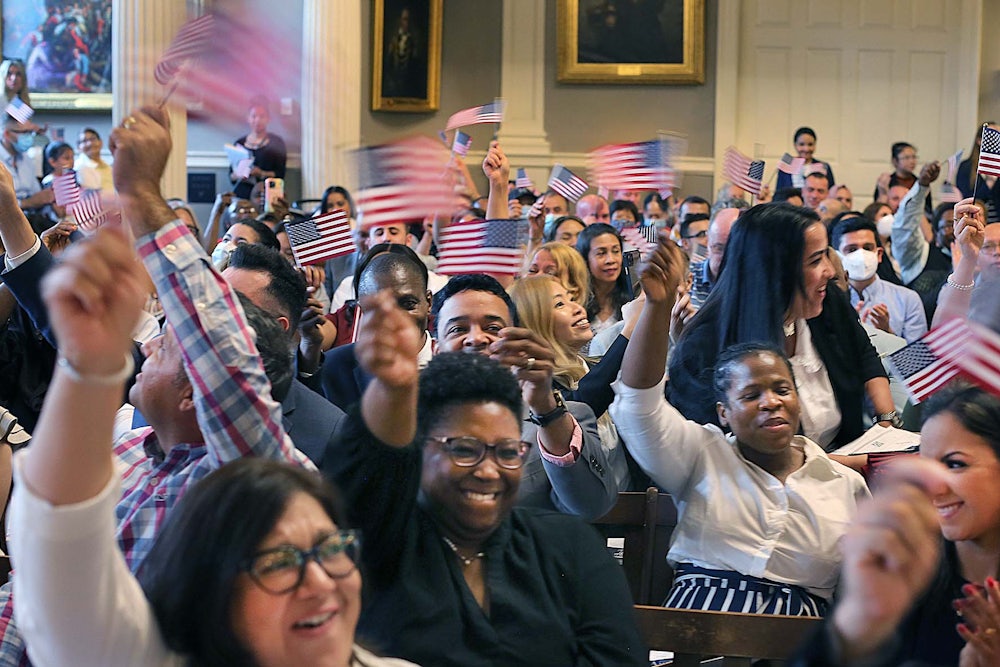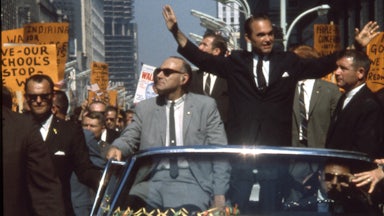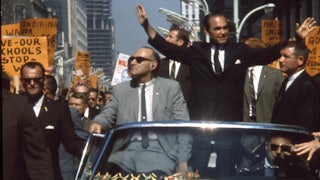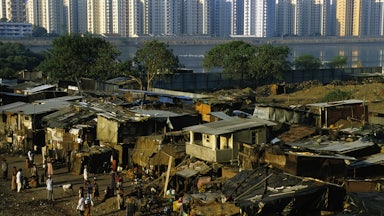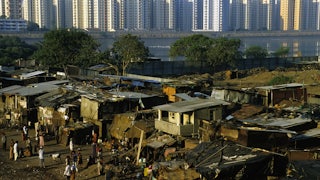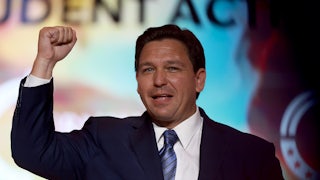Deepak Bhargava has a big idea: America should live up to the best parts of our national identity and become the most welcoming country on earth for immigrants and refugees. Bhargava’s Statue of Liberty Plan proposes welcoming 75 million people over the course of the next decade. To do that, and to counter broad authoritarian appeals, we need a new narrative about immigration, rooted in progressive values.
Bhargava is a distinguished lecturer in urban studies at the City University of New York and a senior fellow at the Roosevelt Institute, and his ideas come at a crucial moment. In the coming years, an existing trend will accelerate: The people who contributed the least to the climate crisis will bear the worst of its effects. According to the World Bank, by 2050 there will be 143 million climate migrants from Latin America, sub-Saharan Africa, and Southeast Asia. Given the scope of our country’s historic contributions to the climate crisis, this presents an urgent question. As Bhargava asks, “If you burned your neighbor’s house down and they came to your door, knocking, asking for refuge, what’s your responsibility?”
On episode 5 of How to Save a Country, hosts Michael Tomasky and Felicia Wong discuss the moral imperatives behind a progressive vision for immigration and what kind of civil society movement would be necessary to see it through. Bhargava also talks about his vision and strategy for the broader progressive movement: Return to the fundamentals of organizing. Listen seriously to what people want and need. And tell a good story that makes sense. “There are millions and millions of people in this country who would participate in its renewal, who would participate in this fight if they are asked,” he says. “We can win this.”
How to Save a Country is presented by the Roosevelt Institute, The New Republic, and PRX. Generous funding was provided by the William and Flora Hewlett Foundation and Omidyar Network. Views expressed do not necessarily reflect the opinions and beliefs of its funders.
Reading recommendations
• Immigration Matters: Movements, Visions, and Strategies for a Progressive Future, a powerful book of essays co-edited by Deepak Bhargava, Ruth Milkman, and Penny Lewis
• “The Platypus,” Bhargava and Harry Hanbury’s Substack newsletter about politics, organizing, movements, and art
• Bhargava’s opinion pieces for The Nation; a Title 42–focused op-ed for CNN that he co-wrote with Pramila Jayapal, the Democratic representative from Washington; and “The U.S.’s ‘Immigration Crisis’ Is Admitting Too Few Immigrants, Not Too Many,” an article Bhargava co-wrote with Roosevelt fellow Rich Stolz about their Statue of Liberty Plan
• Learn more about Leadership for Democracy and Social Justice, where Bhargava is a founding director. For more ways you can help, check out Welcome.US, which does incredible work to support and welcome those seeking refuge.
• The Statue of Liberty Plan: A Progressive Vision for Migration in the Age of Climate Change, a report for the Roosevelt Institute by Bhargava and Stolz
• A New Paradigm for Justice and Democracy: Moving Beyond the Twin Failures of Neoliberalism and Racial Liberalism, a report for the Roosevelt Institute by Kyle Strickland and Felicia Wong
Michael Tomasky: I’m Michael Tomasky, editor of The New Republic.
Felicia Wong: And I’m Felicia Wong, president and CEO of the Roosevelt Institute.
Michael: And this is How to Save a Country, our podcast on the ideas and the people contributing to a new political vision and a new economic vision for the United States. We connect the economy, democracy, and freedom.
Felicia: Because progressives need a common purpose and a common strategy to win.
Michael: Perhaps no issue shows just how interconnected these concepts are than the one we are talking about this week: immigration.
Felicia: We are only two years past the most anti-immigrant administration in recent memory. Two major policies underscored former President Trump’s hateful stance toward immigrants. First, the Muslim travel ban, which barred people from seven predominantly Muslim countries from entering the United States.
Michael: And second, the child separation policy, which explicitly tried to discourage south and central Latin American migrants from coming to the United States by taking children away from their parents.
Felicia: The vast humanitarian crisis at America’s southern border is a much broader issue than even Donald Trump made it out to be. Immigration reform has really frustrated one presidential administration after another. The flow of people fleeing violence and climate disaster for a chance at a better life will only grow.
Michael: Plus the fact that Trump struck such a xenophobic chord, one that, let’s admit it, resonated with a big segment of the American people, has put progressives on the defensive.
Felicia: Our guest today argues that it’s time to play offense. We need to build a progressive vision of immigration. And he argues that if progressives invite people into our vision, we can win big.
Deepak Bhargava [clip]: This is kind of my gospel, that there are millions and millions of people in this country who would participate in its renewal, who would participate in this fight if they are asked.
Michael: Before we get rolling, a humble request for our listeners. Please subscribe to the show wherever you get your podcasts, and if you’re so moved, leave us a rating or a review. How to Save a Country is, as you can tell from the title, a big project, and we can’t do it without listeners like you.
Felicia: You can even connect with us both on Twitter. I’m @Felicia WongRI.
Michael: I’m @MTomasky.
Felicia: We’re fortunate to be speaking today to Deepak Bhargava. Deepak is a remarkable secret weapon in progressive life. He formerly ran Center for Community Change and is now a distinguished lecturer at the School of Labor and Urban Studies at CUNY in New York. He’s a guy who dreams big, and he also gets stuff done. He’s been a leader for decades in the fight for immigration reform in this country. Deepak, welcome to How to Save a Country.
Deepak: Thanks, Felicia. It’s great to be with you. Great to be with you, Michael.
Michael: We’re thrilled to have you.
Felicia: So Deepak, let’s start with immigration, both as a puzzle and as a political football, but also as one of your dreams because you have a real vision for what immigration in this country can be. You say that mass immigration is key to the American renewal. That’s of course directly contrary to most of today’s immigration narrative, certainly to the immigrant threat narrative that dominates our national conversation. I’m going to quote you back to yourself here: “Our economy, politics, and culture all need the revitalization that only immigrants can provide and a new paradigm for vastly greater levels of immigration must be a central priority on both moral and strategic grounds. Such an approach is crucial to the wellbeing of immigrants and to the social democratic project itself.”
Deepak, that is a big claim, so let’s start there.
Deepak: Yeah, I’ve been stewing on this for some time, as you know, and I think the place I want to start is actually with grief and the level of grief I felt seeing the pictures we all saw of how Central American migrants and Haitian migrants were treated at the southern border. The grief really quickly turned to anger as it became really painfully clear to me that our political system is just currently incapable of responding to that challenge in a humane and effective way. The story we have right now is we’re going to have tens of thousands, ultimately millions, of people traveling north for all kinds of reasons: authoritarianism, rising climate change, economic conditions. We have one political party that has weaponized that migration for political gain and another party that’s essentially politically incoherent on the topic that is embracing a softer version of restrictionist politics. So it coarsens our politics to have a situation where there’s a tremendous moral catastrophe unfolding at the border and the country looks away from it.
Felicia: Yeah, totally.
Deepak: So why not awaken the best parts of our national identity, which admittedly we rarely live up to, but they’re there, of being a welcoming country? Why not root a new vision for welcoming, for mass immigration in that best part of the American tradition?
Felicia: Is that all part of your Statue of Liberty plan? I know that you’ve published about and talked a lot about the Statue of Liberty plan. Can you tell our listeners about what that is exactly?
Deepak: So the idea is that our North star goal would be to be the most welcoming country on earth for immigrants and refugees. To do that, we would actually set an immigration target. The target I propose is 75 million people over the course of a decade. In the Obama years, we were probably admitting a million a year. We would go to admit something like seven or seven and a half million per year to reach that target over a decade, with full labor rights and the ability to naturalize and to bring family members to be full members, participants in our democracy and society. I know this seems counterintuitive given where our politics have been frozen, but the moral aspect, the humanitarian aspect is clear. The economic mandate is also clear. The country is aging rapidly, and the ratio of workers to retirees is unsustainable and will be even more unsustainable in years to come. There are related parts of it, like we would have to build a massive integration infrastructure, to contemplate it, like this is the part that’s about the national project of renewal; that we would have to essentially build civil society’s capacity to do this on a very massive scale, as well as government’s capacity to do this. We’d need to think about how we dismantle our current immigration structures, our bureaucracies, the Department of Homeland Security, which is a relatively new and very malign actor in our government, and essentially create an entirely new set of systems for welcoming that number of people over that period.
Michael: So how does that change our current political culture? You’re talking about, in other words, work that needs to be done, as you said, over the course of a decade. I agree with you, and I think Felicia would agree as well. This is a long-term project. We have popular support for a lot of the kinds of things you’re talking about, actually pretty decent levels of popular support, but they are blocked by, as you say, the xenophobic recalcitrants of the one party and the ambivalent, shall we say, of the other party.
Deepak: This question of the use of moral panics to build the political constituency for far-right candidates, for authoritarianism, I think it is the defining political challenge of our time. Immigration is case example one, but the same challenge exists for critical race theory, for attacks on trans people, and so on and so forth. I believe in the argument that Heather McGhee and Ian Haney López and others have made that the right response to the moral panic, to the fear-based argumentation is to counterpose an argument of a “we,” to basically call it out and say, “This is what is being done. You’re being divided on this basis for political gain and for profit,” and here’s the alternative. Here’s the vision of how we prosper and live together that has to come from the top.
We do need leaders who can make the case for immigration as being in the national interest, the economic interest, and articulate the case for future migration. It’s very striking to me that the one exception to the worldwide bout of nativism that we’ve had is Germany and the decision by Angela Merkel to welcome Syrian refugees. There was a civil society outpouring of millions of people welcoming Syrian refugees, and there was some leadership from the top. It has got to be a dynamic between those two things, but the elements of a broad civil society coalition for welcoming are there and we need to activate it to build it. A lot depends on our success in that.
Michael: How do we move from the current grim political reality to a more hopeful place?
Deepak: Part of the way I think about it is there was a time when the status of the 11 million undocumented people in the United States was an untouchable topic. We still haven’t reached the goal of a path to citizenship, obviously, but the way it moved into the political discussion was through a massive engagement of civil society, a change in the labor movement, an activation of faith communities, massive community organizing projects all over the country. I see a similar trajectory now needed on this question of future migration. So I don’t know that this is going to start in the political realm, but you began to see the seeds of it in the response to Afghan refugees, where you had even conservative-leaning Rotary clubs, Lions clubs, these kinds of institutions take on the task of sponsoring migrants. What I’m really proposing is kind of a massive civil society project first to activate these pillars of society, to welcome immigrants through the job of integrating immigrants to build a mass base.
Michael: Is there anyone in the political world, in Congress, in politics, who is doing that kind of civil society long-term thinking and talking that you just suggested?
Deepak: The conversation on immigration honestly has been frozen for, I’d say, 15 years. We’ve been debating within the same narrow box—more enforcement at the border and legalization—and we’ve been stuck on that conversation for over a decade. There are some seeds of new thinking. Notably Pramila Jayapal, who came out of the immigrant rights movement, has been developing some ideas of what a new forward-looking immigration policy could look like. But mostly to be just blunt about it, progressives are on the defense. We’re trying to fight for the stuff we articulated 20 years ago, to get that done, with limited success, and we’re trying to fend off bad stuff. So there’s a big project there.
Michael: How does the Republican Party move on this? How does this movement that you’re talking about get some movement in the Republican Party to change things?
Deepak: This version of the Republican Party has to be beaten decisely and repeatedly. I was around after the 2012 election in Washington when the pundit class, including the Republican National Committee, decided that changing the party’s stance on immigration was essential to its long-term political viability. This is almost unimaginable now to contemplate that this was the consensus in the Republican Party. It didn’t come out of nowhere. It came out of an immense amount of organizing and mobilization that essentially made it impossible for Republicans, or challenging for them, to win in Colorado, in Nevada, and in other key battleground states.
I think the imperative—and I’m sorry it’s such a blunt instrument, but it’s the instrument we have—is that this growing demographic of immigrants and the first generation who usually power this kind of political change has to flex its political muscle in coalition with the other parts of the progressive base to make that kind of nativist racist politics, obviously, unworkable for the Republican Party and to force them to find a different path and to listen to those dissenting voices in the party. Now we’re so far from that that it’s kind of hard to conceive, but it helps me to remember that we were there not so long ago. I’m encouraged by the extent to which there is a civil society response, still small admittedly, on the right side of the spectrum, including some evangelical churches. Then I think the trickiest factor in our politics is the role of the business community. Business-friendly immigration is not something that we would probably support because it involves immigration with limited labor rights, without the ability to bring your family, abusive guest-worker programs, return to all of that. But the Chamber of Commerce has already made a call for two million new immigrants, and so the question is: Could there be a coalition that engages some part of the business community as well as some part of the right civil society base?
Felicia: You are imagining a real new coalition, not just around immigration politics but around American politics overall, where the left, which basically makes a moral argument around welcome, and also I would say a racial argument around welcome, and an economic, not exactly an anti-capitalist argument around welcome, but a recognition that some people have been the victims of capitalism. They’ve been in the global south. They’ve been Black Americans. That’s basically the case that the American left makes. What you are saying is that case has to be married politically to a business case, to a more straightforward economic case for immigration in order for your vision of the Statue of Liberty plan to succeed. Can you talk a little bit more about what you think some of the steps are to getting there?
Deepak: Yeah. This is the trickiest part to me is that if this were to work, if we were to have a policy that actually admitted tens of millions more immigrants in the United States, we would have people arriving at that conclusion through very different arguments. On the left, there’s the moral case. There’s also a need to re-historicize immigration. Essentially, the whole history of immigration in the United States has been turned into a set of individual decisions by millions of people to immigrate. The sense in which factors like U.S. economic and foreign policy have driven migration has been utterly erased from the national conversation. The left has a role in building that narrative and telling it to make the case. I think the climate crisis is another dimension of that case. That set of stories, moral, historical, climate, is going to have to meet a set of stories about the national brass tacks reality that the United States will reach a demographic tipping point in the absence of immigration that will make programs like Medicare and Social Security difficult or impossible to finance, that will make caring for an elderly population impossible, that will create all kinds of problems for the tax base. That argument is not necessarily the argument that leftists will make, and maybe they shouldn’t make it, but it’s an argument we’re going to have to live with to get to a winning politics on the issue, I think.
Michael: Who should make that argument?
Deepak: Ideally, I think this would be an argument that centrist and conservatives make about grounding more immigration in a frame about the national interest. You do see it occasionally—as I said, the Chamber of Commerce and business interests are promoting immigration as key, but it is not part of mainstream Democratic or Republican discourse yet.
Michael: You said a few moments ago, millions more immigrants. I assume some of these economic factors were some part of your calculations about how you arrive at your number.
Deepak: Well, actually they weren’t. OK, the way I came to it was the hypothesis that we want to be the most welcoming country on earth for migrants and refugees, that that is a core part of the country’s DNA and identity. Then you ask, “Well, what does that actually mean?” It means a lot of things, but one thing it might mean would be to have the highest share of foreign-born population in the world. Right now we don’t. Australia’s far ahead of us. Canada’s far ahead of us. Getting to that point, if you thought about it as a race to be the best, would take doubling the percentage of the U.S. population.
Michael: Which is right now what percent?
Deepak: About 15 percent are foreign born, so it would take the population being 30 percent. That is a call for vastly expanded migration over anything we’ve done since the early part of the twentieth century. It is not a call for open borders. It is a call for a controlled but very generous immigration policy.
Michael: What kind of changes in law would that require?
Deepak: Our current system essentially creates caps that would have to be substantially increased. My proposal would be that we build on the strengths of U.S. immigration law, which emphasizes admissions through family pathways, meaning you have a relative in the United States. We’d build on that. We dramatically expand the humanitarian pathways. Right now there may be up to 65 to 70,000 people who come a year through those pathways. We’d have to increase that by many orders of magnitude. We’d also increase immigration through what’s called the diversity pathway. This is immigration for people from parts of the world that don’t have family members already in the United States, that’s disproportionately from the African continent, and I think it’s a matter of racial justice to think about that as corridor politics. So we’d basically raise the admission levels under all those categories and we’d allow factors like climate change and economic hardship to be qualifying factors for how you can come to the United States, which they are not currently. The countries that have contributed the least to the problem of global warming are going to be experiencing the most devastating impacts in terms of extreme climate conditions for decades. It poses the question: If you burned your neighbor’s house down and they came to your door knocking, asking for refuge, what’s your responsibility? That’s a version of the question that the United States is gonna face, that Europe is facing and failing for the most part right now. I think we need to reinvigorate that notion of cause and effect, of history, and frankly, a moral obligation in the immigration debate.
Felicia: On that note, we’re going to take a quick break, and when we return: What is the progressive game plan beyond immigration policy, and why did the child tax credit make some recipients feel suspicious?
Michael: Welcome back to How to Save a Country. I’d like to broaden the conversation out now from immigration to the progressive movement in general. I think it’s fair to say that things aren’t quite where we thought they would be in the spring of 2021. But at the same time, if you take a slightly longer view of the last few years, I would say that things have moved in a reasonably positive direction such that the sitting president of the United States, for example, who was never known as flaming progressive, has at least tried to do things that the progressive way would be enthusiastic about, didn’t get them all done, but he’s gotten a lot of them done. What lessons do you draw from that? We all draw the lesson that the Democrats need more than 50 senators. But what else?
Deepak: The biggest one I think is that we don’t just need a set of policies that make sense, that we need a story about the economy that makes sense to people. My favorite anecdote about this is, as someone who’s been working on this until recently obscure policy, the refundable child tax credit, for decades, I went into my class where I teach and asked my students after the first checks landed in people’s bank accounts, who got the child tax credit. Every hand almost went up, and I said, “So are you happy about it?” Not a single person responded “yes,” and I probed why. Of course the answer I got back was, “What’s the catch?” Right, so for working-class people of color, the relationship to government is not, “Oh, they’re here to deliver for us.” The relationship is surveil, incarcerate, harass, the government bureaucracy, all of that stuff. It entered into a filter of deep suspicion, and there was no counterposed narrative. There was no grand story about the kind of society we were proposing to build.
The fact that we had the American Rescue Plan without billions and billions of dollars for navigators to explain to people what the benefits were and how they participated, it’s a stunning abdication of basic political competence to me. The muscle of listening has atrophied greatly, and so the ability of asking, “How are ordinary people making sense of their lives? What’s the language they’re using? What do they really care about?” is gone to a really distressing degree from the elites that run the show, and I think it’s going to take a groundswell from below to have any shot at changing. I think it’s going to be a social movement dynamic. I think the patterns of thought are so hardened that I have little optimism that those habits will be broken from the top.
Michael: The Democrats do lack that overall vision. They don’t talk, I don’t think, very often in those broad philosophical terms. They talk about the programs they want to pass. They don’t talk about the kind of society they want to have.
Felicia: Yeah and part of, I think, what you have tried to do to combat that a little bit is to try to get more ordinary people into politics. I mean, why should voters hand us the keys to the car unless we demonstrate that we can actually drive? I’d love you to talk about that because I do know that the right wing has been excellent at this. Take just one example: The Leadership Institute. It’s an organization that spends about $25 million a year. Since 1979 or 1980, they’ve trained 250,000 leaders. They trained Mitch McConnell; they trained Mike Pence; they trained probably everybody who’s currently in the Republican Party. The left, progressives, liberals have really struggled to be able to bring people in and to keep people in these roles for a long time.
Michael: Yeah.
Felicia: I know that at CUNY you have launched a new school for training people who want to do this kind of politics for the long term. How do you think about training? And tell us a little bit about the training and leadership work that you are doing at CUNY.
Deepak: Yeah, I’m very excited to talk about it, and the motto, if you go to the website of that conservative Leadership Institute you were just talking about, the motto is: “You owe it to your philosophy to learn how to win.” To me, that encapsulates what we need to do, and so I built, with a number of movement colleagues, a new institution, Leadership for Democracy and Social Justice, to train early and mid-career people in social change, with a focus on people of color, women, working-class folks. We did a lot of research on how the right develops leaders at the Army War College, at the business schools, and leadership NGOs, and then what the left does. Here’s the fundamental difference. The right focuses on vision and strategy and power. The left institutions focus on technique: how to do an electoral contact plan; how to door knock; how to develop a message. Whereas the right-wing ones are like, “What’s the aspiration of the world? What’s the vision of the world you have? How do you acquire and wield power in whatever sector you’re in? How do you think about strategy and actually winning a campaign, and what are the tools available to you?”
We’re building this institution with the idea that vision, content, about what the world you seek to build is paramount—we’re not looking for technicians, we don’t have enough technicians—and strategy, an orientation to power, winning, governing is fundamental. One of the most encouraging things to me, one of the most inspiring things is to see the reception of intellectual work among this generation’s organizing. We’re putting them through academic classes, and they’re reading serious, historical, political science case studies of other movements, economics, and contrasting political economy visions. My generation of organizers was pretty anti-intellectual. The idea was, let’s just get out there and hit the doors—and I still believe in hitting the doors—and that will solve the problem.
There’s such an appetite to look up to understand the world we live in, to understand what’s happening around the world, to have dialogue with people in different sectors, and it nourishes people’s ability to create new pathways.
Michael: Speaking of new pathways, Deepak, I think now is the perfect time to ask you our show’s signature question: How would you save our country?
Deepak: I think the single most important thing is a return to the fundamentals of organizing on the left, and that’s different than mobilizing, which is taking people who already agree with you and agitating them further, perhaps turning them out to a rally, et cetera. The Trump years were very bad for the organizing muscle because so many people were agitated that you could put out a call and lots of people would show up. Social media has been very bad for the organizing muscle, but those fundamentals are deep, serious listening, engaging people in a deep way on vision and ideas and strategy, and by this I mean everyday people, not just the next thing you’re trying to get them active for, but really investing in people’s capacity to lead, not just to be followers but to really shape their own destiny. Maybe this is the most important thing, reaching out to new people. This was kind of my gospel, that there are millions and millions of people in this country who would participate in its renewal, who would participate in this fight if they are asked. We can win this. The majority of the country are not authoritarians, and right now we are not asking enough.
I’m doing a project with a worker organizing project in the South, multiracial worker organizing project that’s called Raise Up that’s connected to SCIU. It’s one of the most hopeful things I’ve been involved in. There are rooms of hundreds of low-wage workers who work in fast food, who work in retail, who work for far less than the minimum wage, who are scalded, who are burned, who are lacking in all kinds of basic worker protections, and they’re asked, and they show up and they fight for themselves and they fight for their co-workers, and they’re winning in many of these workplaces. I know it sounds old-fashioned, and I am old-fashioned about this, but it is the secret sauce. It’s when we’re recruiting, when we’re listening, when we have big open arms and open hearts, we do win. Whenever we get narrow and insular and talk to ourselves too much, we start to lose, that’s the basic formula for how progressives win in this country.
Felicia: So Deepak, your vision for winning by talking to people who have a stake in the game and for talking to people in ways that create a larger whole and a better union, I think that is a way to save our country. So I just want to thank you so much for spending this time with us.
Michael: Thank you so much for joining us.
Deepak: Thanks, Felicia. Thanks, Michael. It’s a delight to be with you.
Michael: Felicia, It strikes me that two of our recent guests on this podcast, Dorian Warren and Deepak Bhargava, have both kind of wrung their hands about progressives’ inability to tell a good story. Here’s Dorian.
Dorian Warren [clip]: So I get frustrated, maybe this is to the critique of the Biden administration. Can you tell a damn good story for once? Like it’s just remarkable to me how this administration is incapable of telling a really clear story with a plot, with a protagonist, with a villain, with some hope, with some challenges.
Felicia: And then Deepak brought it up when talking about the suspicions his students had when they received the child tax.
Deepak [clip]: It entered into a filter of deep suspicion, and there was no counterposed narrative. There was no grand story about the kind of society we were proposing to build.
Michael: So Felicia, what do you think is going wrong here?
Felicia: I think that there are so many of us who are well-intentioned policy nerds that we get caught in the laundry lists and we don’t think about or even really deeply feel that North star, that long arc, that vision of the society that we’re trying to build. I think we do ourselves a disservice because we don’t speak broadly to people’s deepest hopes when we talk just about percentages or dust about data.
Michael: And you know, policies, they just have to be connected to something more emotional, a vision for society. What kind of society do we want, and what’s it look like? That’s the missing piece in a lot of progressive and liberal political rhetoric. I understand why it’s the case. It’s decades of defensiveness going back to the 1980s when conservatism was ideologically ascendant. Conservatism is no longer ideologically ascendant. I think that seesaw has balanced out.
Felicia: Maybe social conservatism might be, which is a different topic, but I definitely agree with you that a sort of libertarianism is not ascendant, conservative libertarianism.
Michael: Yeah but it’s still gonna take politicians, and the younger generation of elected officials is better at this than the older generation, but it’s still going to take time for people to realize that you just have to say, without apology, what you stand for, why you stand for it, and here’s this kind of society that it’s going to give us. There’s a lot of loud people on the other side who object to that vision, but there are millions and millions of Americans who support and back that vision.
Felicia: I also think, Michael, that it’s related to your notion that we need to reclaim freedom, and I would even go further to say that there is a version of freedom that is truly progressive. Look at the abolition movement. Look at the Women’s Liberation Movement. Look at the civil rights movement. People were calling there for a deeply felt freedom that I think we can access today, and if we can do it in a way that also connects to a more equitable and stable economic life, so much the better.
Michael: Yeah, it’s like we discussed with Heather Cox Richardson when she talked about the difference between “freedom to” and “freedom from.” The right emphasizes “freedom from.” Our side needs to emphasize “freedom to,” and that means some actor, the government, giving people the tools to live up to their fullest potential.That’s freedom. That’s a different and better kind of freedom. I think that connecting economic policies to that, as you’ve heard me say a million times, my friend, I apologize, butI think that’s a political winner.
Felicia: As long as we can tell the story, Michael.
Michael: Yep.
Felicia: How to Save A Country is a production of PRX in partnership with the Roosevelt Institute and The New Republic.
Michael: Our coordinating producer is Cara Shillenn. Our lead producer is Alli Rodgers. Our executive producer is Jocelyn Gonzalez, and our mix engineer is Pedro Rafael Rosado.
Felicia: Our theme music is courtesy of Codey Randall and Epidemic Sound with other music provided by APM.
How to Save a Country is made possible with support from Omidyar Network, a social change venture that is reimagining how capitalism should work. Learn more about their efforts to recenter our economy around individuals, community, and societal wellbeing at omidyar.com.
Michael: Support also comes from the Hewlett Foundation’s Economy and Society Initiative, working to foster the development of the new common sense about how the economy works and the aims it should serve. Learn more at hewlett.org.
Felicia: We’ll be back in a week with another podcast on, what else? How to save a country. So if you’re not following us yet, please do so.
Michael: And of course, throw us a rating. Throw us a review. Felicia, can you tell listeners what they can look forward to next week?
Felicia: Yes. We are going to be joined by Representative Hakeem Jeffries, who is rumored to be in the running for leadership, the leader, of the House Democrats. Representative Jeffries is going to talk to us about the kind of economy progressives are trying to build and why middle out is right and trickle down is not.
Hakeem Jeffries [clip]: I’ve finally come to the conclusion over the last several terms that perhaps trickle-down economics is appropriately named for the middle class and those who aspire to be part of it. You may get a trickle, but you’re guaranteed to stay down.
Michael: I like the sound of that. See you then.
Felicia: Figured you would, Michael. See you.
